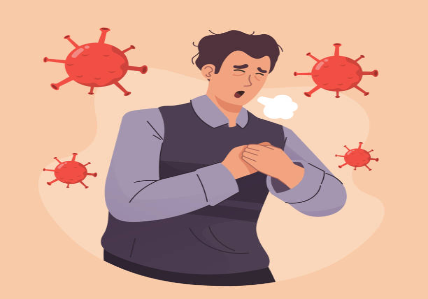COVID-19 can damage the tissue in your lungs and may also affect your breathing patterns, which can cause shortness of breath to linger. It’s possible for this symptom to persist for weeks, months, or years.
One symptom that often lingers after having COVID-19 is shortness of breath. If you have shortness of breath, you’ll feel like you can’t catch your breath. Your breathing may be faster than usual, and it may feel uncomfortable.
Symptoms that persist after you’ve had COVID-19 are considered their own condition: long COVID. It’s quite common. In fact, a 2022 surveyTrusted Source found that close to 1 in 5 people in the United States who recovered from COVID-19 reported having long COVID symptoms.
This article takes a closer look at what we know about the causes of shortness of breath after COVID-19. It will also include information about when to seek medical care and ways to get relief.
What can cause shortness of breath after having COVID-19?
Shortness of breath is a common symptom after COVID-19. A 2022 reviewTrusted Source of 102 studies, many of which involved people hospitalized with COVID-19, found that shortness of breath after COVID-19 had a prevalence of 26%.
Generally speaking, shortness of breath may take up to 13 days to ease after you’ve had COVID-19. In people with long COVID, symptoms like shortness of breath can last for weeks, months, or even yearsTrusted Source.
COVID-19 and your lungs
The respiratory system is typically the first part of the body affected by COVID-19. This can include the upper respiratory tract, such as your nose and throat, and potentially the lower respiratory tract, which includes the lungs.
SARS-CoV-2, the coronavirus that causes COVID-19, infects the cells that line your airways. The viral infection and the inflammation your immune system causes in response to the infection can damage lung tissue.
This includes the alveoli, which are the tiny air sacs in your lungs where gas exchange occurs. Gas exchange involves the movement of vital oxygen into your bloodstream in exchange for carbon dioxide, a waste gas.
When the alveoli become damaged, gas exchange can’t proceed as efficiently. That means that your body may not be getting enough oxygen. As such, you can feel short of breath.
COVID-19 and your breathing patterns
It’s also possible that coping with a respiratory infection like COVID-19 can affect your breathing patterns. These can include things like:
- how you breathe
- the amount of air you take in
- how fast you breathe
These patterns may not return to normal in the initial stages of recovery. Because of this, you may also find yourself short of breath at times.
When should you get medical care?
Some typical aspects of shortness of breath after COVID-19 can include:
- being frequently out of breath, particularly after doing activities like walking or climbing stairs
- having a tightness in your chest when you’re trying to catch your breath
- using your shoulders and upper chest more in order to get air in
- experiencing exercise intolerance, which is when you can’t exercise at a level typical for your age and overall health
If you have shortness of breath after COVID-19, make an appointment with your doctor if your shortness of breath:
- lasts more than a couple of weeks
- continues to get worse
- interferes with your daily activities
- persists even when you’re at rest
Seek emergency care for these symptoms
Some symptoms related to shortness of breath signal a health emergency. Get immediate medical attention if you:
- are having great difficulty breathing
- have shortness of breath along with chest pain that doesn’t go away
- notice that your skin, lips, or nails have a bluish, pale, or gray tint
- have increased trouble staying awake or waking up from sleep
- are experiencing confusion or disorientation
Was this helpful?
What can you do to make breathing easier?
If you have shortness of breath after COVID-19, there are several things you can do to help make breathing easier.
One option is breathing exercises, which can help you better manage your breathing. A breathing exercise to start out with is called diaphragmatic breathing. To do this:
- Sit up in a chair, making sure that your shoulders and chest are relaxed.
- Place one hand on your stomach.
- Slowly breathe in through your nose, taking note as your stomach expands.
- Slowly breathe out through your mouth, feeling as your stomach relaxes back in.
- Repeat several times as necessary.
Other breathing exercises that may be helpful include box breathing and pursed lip breathing.
Additional strategies for dealing with shortness of breath include:
- getting into a comfortable position when you need to catch your breath, such as leaning forward in a chair
- using a handheld fan to blow air into your face
- finding activities that help to lower stress and anxiety, as these feelings can make shortness of breath worse
Shortness of breath after COVID: Tips for coping
The following tips may help make your daily tasks easier if you have shortness of breath:
- Try to break down daily tasks into shorter chunks that are more manageable.
- Prioritize your daily tasks so you can address the most important tasks first.
- Aim to gradually increase the amount of time you spend doing daily tasks.
- Take some time to rest when you need it.
- Don’t be afraid to ask for help with tasks that are particularly strenuous for you.
- Be kind to yourself and don’t do more than is comfortable. It may take some time to recover from shortness of breath after COVID-19.
